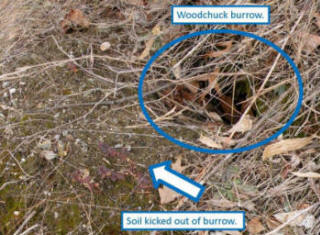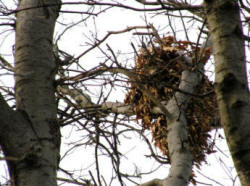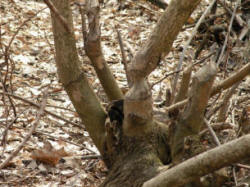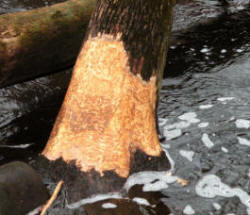|
|
Science: Wildlife Tracks and Signs - Other
Signs
In addition to tracks, there are a wide range of other clues to
look for when investigating the activity of wildlife.

Other signs to look for, in addition to scat include:
- Trails through thickets and along the water’s edge (mammals)
- Tunnels or channels in snow (rodents, insectivores)
- Tree cavities (rodents, birds)
- Scratches on ground or on trees (mammals, birds)
- Midden, such as piles of mussel shells or seed shells
and husks on rocks, under trees, or along river’s edge (rodents,
weasels, raccoons)
- Nests and dreys (birds, squirrels)
- Burrows in the riverbank, under roots, logs, and rocks
(rodents, insectivores, amphibians, belted kingfishers and other
birds)
- Slimy secretions (slugs)
- Peculiar sounds, especially from birds, amphibians, insects
- Plants, such as pokeweed or oak trees; plants which
may have been planted by animals (seed dispersal, see Scat!
section)
- Piles of feathers or fur, etc. (where predators have munched
or their prey)
|

|
A woodchuck burrow, as seen during winter along the
banks of the Concord River reveals the entrance to the home
of a hibernating herbivore.
Woodchucks are rodents in the squirrel family and will dig
burrows with multiple entrances. Their winter burrows can
be five or deeper underground, deep enough to reach below
frost line, where they are able to safely hibernate.
|
| This is the drey of a grey squirrel. Squirrel dreys
are often mistaken for bird nests. These cozy homes can be
found throughout Lowell and are often spotted along the
Concord River, especially during winter months when they are
most visible. Squirrels can also be seen using tree
cavities and even man-made structures for shelter. |

|


Beavers are common along the Greenway. Beaver “chew”
(above-left) can be observed along the Concord River all the way
into downtown areas. Beavers will cut down trees or remove branches
for use as building materials. However, in rivers, such as the
Concord, it is not likely that beavers would be able to construct
one of their impressive dams, because of strong water currents. On
the other hand, it is possible to see beavers living in burrows
along river banks or within lodges constructed of sticks and mud
(similar look to dams) with underwater entrances. Beavers also use
trees as a food source (above-right), dining on their inner-bark and
cambium layers.
|
|





